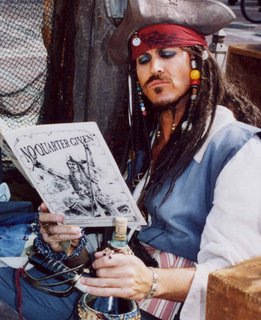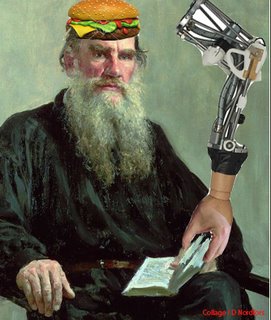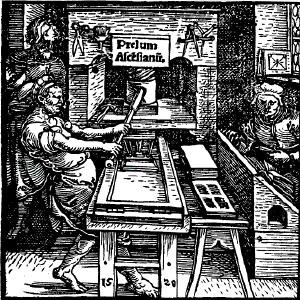 Information technology has topsy-turvied the sense of who can do what with the creative work of other people. Ten years ago, nobody would have imagined the Pirate Party - the Swedish political party proposing it is a human right to share music and entertainment on the Internet without following the standard copyright rules.
Information technology has topsy-turvied the sense of who can do what with the creative work of other people. Ten years ago, nobody would have imagined the Pirate Party - the Swedish political party proposing it is a human right to share music and entertainment on the Internet without following the standard copyright rules.Today, everyone - including journalists - who want to understand innovation in markets for creative work must understand the copyright debate. It is about how we relate to art, entertainment or journalism, and how people working with it will earn a living. It is about how we will use computers and how the computer industry will look like, because the source code for computer software is under copyright protection. With the Internet, it has become a new game, but the copyright rules are still pretty much the same as before. Many people are ignoring them. The consequences are very strong in all fields that publish creative work.
This is the reason why EJC - the European Journalism Centre and my Injo program at Stanford organized the conference "Innovation Journalism: Copyright and the Use of Creative Commons" at the EJC HQ in Maastricht on 13 Oct 08. EJC has an excellent coverage of the event on their website.
Here is a short presentation of the invited speakers:
The key issue in all copyright protection is that of 'fair use'. 'Fair use' is
 the exception to the rule, cases where it is OK to copy, because you are adding so much of your own creativity that the end result is to be considered as yours. The Director of the Fair Use Project, Tony Falzone from Stanford, talked about this, and how it is applied on the Internet. Tony works with Stanford Professor Lawrence Lessig , the father of Creative Commons that "provides free tools that let authors, scientists, artists, and educators easily mark their creative work with the freedoms they want it to carry." It is an effort to carry copyright into the Internet age.
the exception to the rule, cases where it is OK to copy, because you are adding so much of your own creativity that the end result is to be considered as yours. The Director of the Fair Use Project, Tony Falzone from Stanford, talked about this, and how it is applied on the Internet. Tony works with Stanford Professor Lawrence Lessig , the father of Creative Commons that "provides free tools that let authors, scientists, artists, and educators easily mark their creative work with the freedoms they want it to carry." It is an effort to carry copyright into the Internet age.Richard Horning is a partner at law firm Fish and Richardson and advisor to the Innovation Journalism program at Stanford. He talked
 about intellectual property protection and the freedom of the press (the first amendment here in the US). Rick showed how laws covering intellectual property and trade secrets have increasingly been used in order to silence journalists. Paradoxically, blogging is also making it more complicated to protect free speech in the court rooms - it is no longer obvious who is a journalist and who is not, and who should be protected by the first amendment. A typical case is Apple vs. Bloggers, where Apple sued a group of bloggers for revealing company secrets. Rick has a long background in both first amendment and intellectual property and innovation, and shared a number of glimpses into history with us. He for example was the legal councel of the Rolling Stone magazine when they were subpoenad to reveal the sources for their interview with the Symbionese Liberation Movements, the kidnappers of news tychoon heiress Patty Hearst, who after being kidnapped started appearing as one of them. (The Rolling Stone magazine was a venture capital funded startup at that time, with the same investors as a semiconducter startup called Intel.)
about intellectual property protection and the freedom of the press (the first amendment here in the US). Rick showed how laws covering intellectual property and trade secrets have increasingly been used in order to silence journalists. Paradoxically, blogging is also making it more complicated to protect free speech in the court rooms - it is no longer obvious who is a journalist and who is not, and who should be protected by the first amendment. A typical case is Apple vs. Bloggers, where Apple sued a group of bloggers for revealing company secrets. Rick has a long background in both first amendment and intellectual property and innovation, and shared a number of glimpses into history with us. He for example was the legal councel of the Rolling Stone magazine when they were subpoenad to reveal the sources for their interview with the Symbionese Liberation Movements, the kidnappers of news tychoon heiress Patty Hearst, who after being kidnapped started appearing as one of them. (The Rolling Stone magazine was a venture capital funded startup at that time, with the same investors as a semiconducter startup called Intel.)Evi Werkers and Sari Depreeuw, law researchers from FLEET - Flemish E-publishing Trends in Brussels, discussed the controversies between Internet search companies and content producers. They told the details about when Belgium became the center world attention two years ago, when a court in Brussels ordered Google News to remove all links to stories published by Belgian newspapers. The news stories are until today searchable only through local Flemish and French search sites.
In 2001 poet Jonathan Bailey got the adrenalin shock of his life when
 he found a large part of his own poetry and prose republished on an anonymous website. He tracked down the owner of the site and phoned the person, prepared for a hard fight. He found himself speaking to a 14 year old kid. Jonathan got fascinated by the problem of online plagiarism, and founded the website PlagiarismToday. He has since then resolved over 700 cases of plagiarism and turned it into a business. Jonathan has published a series of papers with thoughts on how to stop plagiarism on the Internet. He has written his own blog post about the Injo event in Maastricht (here).
he found a large part of his own poetry and prose republished on an anonymous website. He tracked down the owner of the site and phoned the person, prepared for a hard fight. He found himself speaking to a 14 year old kid. Jonathan got fascinated by the problem of online plagiarism, and founded the website PlagiarismToday. He has since then resolved over 700 cases of plagiarism and turned it into a business. Jonathan has published a series of papers with thoughts on how to stop plagiarism on the Internet. He has written his own blog post about the Injo event in Maastricht (here).Prof Gundolf S. Freyermuth from the International Film School in Cologne is an old friend of the Innovation Journalism program. A former lifestyle journalism pioneer in Germany, he has told stories about not fitting into the traditional news beats that many innovatio
 n journalists are living with today. This time Gundolf traced the origins of copyright, starting in the renaissance. Five hundred years ago, making a copy was just as expensive as making the original. The introduction of the printing press made copyright a real issue. Now that the printing press is being replaced by the Internet, another big change is under way. Gundolf thinks we will all be winners.
n journalists are living with today. This time Gundolf traced the origins of copyright, starting in the renaissance. Five hundred years ago, making a copy was just as expensive as making the original. The introduction of the printing press made copyright a real issue. Now that the printing press is being replaced by the Internet, another big change is under way. Gundolf thinks we will all be winners.The presentations of the speakers are available on the EJC website.
I want to thank everyone at the EJC for putting together this enjoyable event: Willi Rütten, Biba Klomp, Bianca Lemmens, Arne Grauls, Bernd Kapeller, Ivan Picart, Kathlyn Clore and Ruth Spencer. They are very valuable friends, doing very important work.















1 comment:
I really liked the presentation of the speakers.Especially i liked the presentation of Richard Horning.
Post a Comment